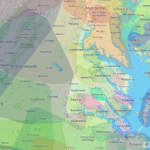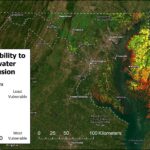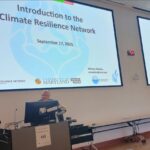Weather Events and Sea Level
The Chesapeake Bay plays a vital socio-economic role in the surrounding region, contributing over $100 billion annually in economic benefits [Phillips and McGee, 2016]. However, the region faces increasing threats from sea level rise, extreme weather events, and climate change [Jay et al., 2023]. Rising sea levels and stronger storms have led to more frequent and severe flooding which impacts communities, infrastructure, and ecosystems.
To prepare for these threats, scientists and city planners need accurate water level data. HydroNet is a network of low-cost water level sensors designed to gather data to enhance flood monitoring and prediction capabilities. By integrating these observations with weather conditions and NOAA tidal predictions, HydroNet aims to improve coastal resilience, and the ability of communities to withstand and recover from coastal hazards like storms, flooding, and sea level rise. Hydronet data also supports local, state, and federal decision-making [University of Maryland Climate Center, 2024].
This study examines how weather conditions, particularly Tropical Storm Debbie (August 7-11, 2024), influence water levels in Annapolis. By identifying anomalies, which are extremes in sensor data, and correlating them with meteorological factors, this research seeks to better understand how storms impact flooding and improve future predictions.
How Storms Change Water Levels
Storms can cause major changes in water levels with a greater impact on low-lying coastal areas like Annapolis. The city’s location along the Chesapeake Bay makes it vulnerable to flooding, which can disrupt daily life and damage homes and businesses. Storm surges, wind speed and direction, open water, heavy rain, and tides all contribute to water level fluctuations. When these forces combine, the risk of flooding increases, which can close roads, damage buildings, and impact businesses [NASA, 2024; NOAA, 2024].
Storm Surges: When Wind Pushes Water onto Land
Storm surges occur when strong winds push a massive wall of seawater toward the shore, driving water levels higher than normal tides. Storm surges can be powerful enough to flood streets, damage buildings, and make it harder for people to get around. Downtown Annapolis has flooded many times because of storm surges, especially during hurricanes and tropical storms [NASA, 2024].
Heavy Rain: Too Much Water at Once
Storms bring a lot of rain, which can make flooding worse. If too much rain falls too quickly, the ground and storm drains can’t absorb it fast enough. This extra water flows into rivers and bays, making the water levels rise even more. In Annapolis, this is a big problem because the stormwater system can only handle so much water at once. When heavy rain happens at the same time as high tides or a storm surge, the flooding can be even worse [City of Annapolis, 2024].
Tides: Natural Changes that Can Make Flooding Worse
Tides naturally raise and lower water levels twice a day. Scientists measure tides using predetermined thresholds like Mean Higher High Water (MHHW) and Mean Lower Low Water (MLLW) to track these changes. In Annapolis, high tides already cause inconvenient flooding, so when storm surges or heavy rain coincides with high tides, flooding can become severe [NOAA, 2024].
Flooding in Annapolis has caused road closures, damage to businesses along the waterfront, and problems for emergency response teams. Since storms are getting stronger and sea levels are rising, it is important to study these changes and find ways to predict and prevent future flooding [City of Annapolis, 2024].
Tropical Storm Debby: A Flooding Disaster in Annapolis
Tropical Storm Debby formed off the southeastern U.S. coast and strengthened as it moved northward, bringing tropical storm-force winds and heavy rainfall to the Mid-Atlantic region from August 7 to August 11, 2024. The storm produced sustained winds of up to 55 mph, knocking down trees and power lines in multiple areas along its path. Debby also generated significant storm surges and extreme rainfall, causing flooding across coastal communities, including Annapolis [Weather.gov, 2024].
Annapolis experienced some of the worst flooding from the storm, with floodwaters at City Dock rising to 4.4 feet above normal levels on August 9, making it the eighth-highest flood event on record for the area [CBS News, 2024]. The combination of storm surge, high tides, and torrential rainfall overwhelmed the city’s drainage systems, leading to widespread road closures and damaged businesses in the historic downtown district. Emergency responders had to rescue stranded individuals from vehicles caught in floodwaters, highlighting the dangers posed by such extreme weather events [Weather.gov, 2024; CBS News, 2024].
A Hydronet Perspective on Observed Data
Understanding the observed data during Tropical Storm Debby provides insights into how meteorological conditions influenced water levels in Annapolis. By analyzing water trends and weather patterns, we can better understand how extreme weather events contribute to coastal flooding.


Looking at HydroNet’s data from their water level sensor at the Annapolis City Dock (Fig.1), we can see that water levels peaked on August 9th. This is more than just a change in tides, the water level was above average. Peak precipitation occurs 24 to 48 hours (NOAA CO-Ops 00180700, Beltsville MD) before the peak in water levels at Annapolis city dock (Fig. 2). The time delay between peak precipitation and peak water levels points to the possibility of other factors besides precipitation causing high water levels. There is an expected delay between peak rainfall and peak flooding of nearby rivers but in urban areas like Annapolis the delay is less than 24 hours.
The most likely cause of the flooding is storm surge caused by constant winds pushing a wall of water in one direction. Wind speed and direction data collected at the NOAA CO-OPs station 8575512 located in Annapolis, Maryland shows an increase in wind speed (red) and wind direction (black arrows) beginning on August 9th and continuing for 12-18 hours (Fig. 3).

Davies et al. showed that 3-hour winds sustained over 20 miles per hour from the southeast can cause water levels 1.5 feet or more above the MHHW mark. Tropical storm Debby produced constant winds of 20 plus miles an hour from the southeast for 12-16 hours. This leads us to conclude that the peak water levels in Annapolis on August 9th from T.S. Debby were most likely due to the winds that occurred after the peak rain on August 7th and 8th this peak.
Flooding in Annapolis has caused road closures, damage to businesses along the waterfront, and problems for emergency response teams. Since storms are getting stronger and sea levels are rising, it is important to study these changes and find ways to predict and prevent future flooding [City of Annapolis, 2024]. HydroNet’s sensor network provides invaluable data during storms, offering a clearer picture of how various meteorological factors influence flooding. However, data collection alone is not enough. To truly mitigate the impacts of future storms, these insights must be transformed into actionable solutions through investment in flood prevention measures, expanded water monitoring networks, and climate adaptation policies.
A Climate-Focused Future
Tropical Storm Debby caused major flooding in Annapolis, demonstrating how dangerous weak tropical storms and rising sea levels can be to coastal communities in Maryland. The storm brought strong winds and heavy rain, leading to one of the worst floods the city has ever seen. This disaster reminds us that coastal areas like Annapolis are at high risk and need to be better prepared for future storms.
Hydronet’s sensors helped track these changes and gave important information to city officials and emergency workers in real time. By combining this data with NOAA’s tide predictions and weather reports, we can better predict floods and reduce damage. To protect Annapolis and other coastal areas, we need to build stronger flood defenses, improve water monitoring systems, and take action to prevent future flooding.
References (Click to Expand)
CBS News. (2024). Tropical Storm Debby brings historic, dangerous flooding to Annapolis.
https://www.cbsnews.com/baltimore/news/tropical-storm-debby-brings-historic-dangerous-flooding-to-annapolis/
City of Annapolis. (2024). Flood information.
https://www.annapolis.gov/312/Floods
Davies, A. R., Smith, J. P., Mandell, D. S., Davis, G., & Wan, F. Y. (2022). Sustained wind forcing and
water level anomalies in Annapolis, Maryland. Earth Interactions, 26(1), 52–65. Retrieved from https://doi.org/10.1175/EI-D-21-0013.1
Hohonu. (2024). Annapolis City Dock water level data.
https://dashboard.hohonu.io/map-page/hohonu-81/AnnapolisCityDock,MD
Jay, A. K., et al. (2023), Overview: Understanding risks, impacts, and responses, in Fifth National Climate Assessment, edited by A. R. Crimmins, C. W. Avery, D. R. Easterling, K. E. Kunkel, B. C. Stewart and T. K. Maycock, U.S. Global Change Research Program, Washington, DC, USA, doi:10.7930/NCA5.2023.CH1.
National Centers for Environmental Information. (March 1, 2025.). COOP hourly precipitation data for Beltsville, MD (USC00180700). NOAA.
https://www.ncei.noaa.gov/access/search/data-search/coop-hourly-precipitation
National Weather Service. (2024). Tropical Storm Debby report.
https://www.weather.gov/ilm/TropicalStormDebby2024
NASA Sea Level. (2024). Short-term effects of regional sea level.
https://sealevel.nasa.gov/understanding-sea-level/regional-sea-level/short-term-effects/
NOAA Tides & Currents. (2024). Datum options.
https://tidesandcurrents.noaa.gov/datum_options.html
Phillips, S., and B. McGee (2016), Ecosystem Service Benefits of a Cleaner Chesapeake Bay, Coastal Management, 44(3), 241-258, doi:10.1080/08920753.2016.1160205.
University of Maryland Climate Center. (2024). Monitoring coastal flooding.
Authors

Katherine Lehman
Student Intern
Ava Puschnigg
Student Intern

Mike Maddox






